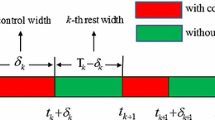Abstract
This paper mainly studies the synchronization problem of fractional-order directed complex networks through partial pinning control. Unlike other papers, the network studied in this paper is neither strongly connected nor contains directed spanning trees. By utilizing the directed acyclic graph condensation and Layering theory, the network is decomposed into several strong connected components and then divided into layers. It proved that all or part of nodes in the network can achieve synchronization with the pinner’s trajectory, only when the root strong connected components in the upstream of these nodes are pinned and satisfy some sufficient conditions. In addition, according to the ControlRank algorithm, an optimized strategy is designed to solve the problem of the optimal selection of the pinning nodes to ensure the specific nodes of the network can achieve synchronization eventually. Meanwhile the amount of control energy cost will also be given in this paper. Finally, two simulation examples are given to verify the reliability and feasibility of the optimized algorithm.










Similar content being viewed by others

References
Liang X, Liu Z, Li B (2009) Weak signal transmission in complex networks and its application in detecting connectivity. Phys Rev E 80(4):046102
Mall R, Cerulo L, Bensmail H (2017) Detection of statistically significant network changes in complex biological networks. BMC Syst Biol 11(1):32
Tang Y, Qian F, Gao H (2014) Synchronization in complex networks and its application—a survey of recent advances and challenges. Annu Rev Control 38(2):184–198
Cong Jin, Liu Hai T (2014) Approaching human language with complex networks. Phys Life Rev 11(4):598–618
Erdös P, Rényi A (1960) Additive properties of random sequences of positive integers. Acta Arith 6(1):83–110
Strogatz SH (2001) Exploring complex networks. Nature 410(6825):268
Travers J, Milgram S (1969) An experimental study of the small world problem. Sociometry 32(4):425–443
Jiang J, Wang R, Wang QA (2011) Network model of deviation from power-law distribution in complex network. Eur Phys J B 79(1):29–33
Barabási AL, Albert R (1999) Emergence of scaling in random networks. Science 286:509–512
Zhang Z, Chen M, Li A (2020) Further study on finite-time synchronization for delayed inertial neural networks via inequality skills. Neurocomputing 373:15–23
Zhang Z, Cao J (2018) Novel finite-time synchronization criteria for inertial neural networks with time delays via integral inequality method. IEEE T Neur Net Lear 30(5):1476–1485
Zhang L, Yang Y (2020) Finite time impulsive synchronization of fractional order memristive BAM neural networks. Neurocomputing 384:213–224
Xiang J, Chen G (2007) On the V-stability of complex dynamical networks. Automatica 43(6):1049–1057
Wang X, Chen G (2002) Pinning control of scale-free dynamical networks. Phys A 310:521–531
Chen T, Liu X, Lu W (2007) Pinning complex networks by a single controller. IEEE Trans Circuits I 54(6):1317–1326
Xiang L, Liu Z, Chen Z (2007) Pinning control of complex dynamical networks with general topology. Phys A 379:298–306
Brin S, Page L (1998) The anatomy of a large-scale hypertextual web search engine. In: Proceedings of the seventh international World Wide Web conference, 14–18
Brin S, Page L (1999) The pagerank citation ranking: bringing order to the web. Technical Report, Computer Science Department, Stanford University
Su H, Wang X (2013) Pinning control of complex networked systems. Springer, Berlin
Man KF, Tang KS, Kwong S (1999) Genetic algorithms: concepts and designs. Assem Autom 20(1):86–87
Yang C L, Tang K S, Jia Q (2012) Node selection and gain assignement in pinning control using genetic algorithm. In: 38th Annual conference of the IEEE industrial electronics society, pp 2354–2359
Petráš I (2011) Fractional-order nonlinear systems. Higher Education Press, Beijing
Chang Q, Yang Y, Hu AH (2019) The optimization of synchronization control parameters for fractional-order delayed memristive neural networks using SIWPSO. Neural Process Lett 51:1451–1556
Wang F, Yang Y, Hu M (2015) Projective cluster synchronization of fractional-order coupled-delay complex network via adaptive pinning control. Phys A 434:134–143
Selvaraj P, Sakthivel R, Kwon OM (2018) Synchronization of fractional-order complex dynamical network with random coupling delay, actuator faults and saturation. Nonlinear Dyn. https://doi.org/10.1007/s11071-018-4516-3
Wang L (2013) Directed acyclic graph. Springer, New York
Nuutila E, Soisalon-Soininen E (1994) On finding the strongly connected components in a directed graph. Inf Process Lett 49(1):9–14
Tarjan R (1972) Depth-first search and linear graph algorithms. SIAM J Comput 1(2):146–160
Ding D, Qi D, Wang Q (2015) Non-linear Mittag–Leffler stabilisation of commensurate fractional-order non-linear systems. IET Control Theory A 9(5):681–690
Zhang L, Yang Y (2019) Optimal quasi-synchronization of fractional-order memristive neural networks with PSOA. Neural Comput Appl 32:9667–9682
Last E (1994) Linear matrix inequalities in system and control theory, SAM. Proc IEEE 86(12):2473–2474
Song Q, Cao J (2010) On pinning synchronization of directed and undirected complex dynamical networks. IEEE Trans Circuits Syst I Fundam Theory Appl 57:672–680
Wu CW (2016) On bounds of extremal eigenvalues of irreducible and m-reducible matrices. Linear Algebra Appl 402:29–45
Delellis P, Garofalo F, Iudice FL (2016) Partial pinning control of complex networks. In: 2016 IEEE 55th conference on decision and control
Delellis P, Garofalo F, Iudice FL (2018) The partial pinning control strategy for large complex networks. Automatica 89:111–116
Lu W, Li X, Rong Z (2010) Global stabilization of complex networks with digraph topologies via a local pinning algorithm. Automatica 46(1):116–121
Yi XL, Yang T, Wu JF (2019) Distributed event-triggered control for global consensus of multi-agent systems with input saturation. Automatica 100:1–9
Author information
Authors and Affiliations
Corresponding author
Additional information
Publisher's Note
Springer Nature remains neutral with regard to jurisdictional claims in published maps and institutional affiliations.
This work was jointly supported by the Natural Science Foundation of Jiangsu Province of China under Grant Nos. BK20161126, BK20170171, BK20181342, and the Postgraduate Research & Practice Innovation Program of Jiangnan University under Grant No. JNKY19_042.
Rights and permissions
About this article
Cite this article
Liu, F., Yang, Y., Hu, A. et al. Partial Pinning Control for the Synchronization of Fractional-Order Directed Complex Networks. Neural Process Lett 52, 1427–1444 (2020). https://doi.org/10.1007/s11063-020-10315-7
Published:
Issue Date:
DOI: https://doi.org/10.1007/s11063-020-10315-7



